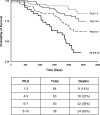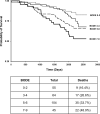Predictors of mortality in elderly subjects with obstructive airway disease: the PILE score
- PMID: 20159492
- PMCID: PMC2827353
- DOI: 10.1016/j.annepidem.2009.11.005
Predictors of mortality in elderly subjects with obstructive airway disease: the PILE score
Abstract
Purpose: To identify significant covariates in addition to spirometry that predict mortality in elderly subjects with obstructive airway disease (OAD).
Methods: Two hundred sixty-eight (268) participants with OAD from the Health, Aging and Body Composition study, a community-based observational cohort of well-functioning elderly aged 70-79 years, were followed on average for 6.1 years. Covariates related to pulmonary and physical function, comorbidity, demographics, and three inflammatory markers (interleukin-6, tumor necrosis factor-alpha, C-reactive protein) were evaluated for their association with all-cause mortality (31%) by means of Kaplan Meier analysis and Cox proportional hazards modeling.
Results: Percent predicted forced expiratory volume in one second (PPFEV1; hazard ratio [HR] = 2.03, p < 0.0001), knee extensor strength (HR = 1.36, p = 0.0002), interleukin-6 (HR = 1.37, p = 0.0002) and 400 m corridor walk time (HR = 1.24, p = 0.008) significantly predicted mortality. A multidimensional index, the PILE score, was constructed from PPFEV(1), interleukin-6, and knee extensor strength. Each one-point increase in PILE score (range: 1-10) was associated with a 30% increase in mortality (95% confidence interval: 0.16-0.47) after adjusting for age, race, gender, smoking, and comorbidity, resulting in a 10.4-fold higher risk of death between the highest and lowest risk category.
Conclusions: Subjects with OAD have a wide gradient of risk for mortality that can potentially be incorporated in clinical decision making.
Copyright (c) 2010 Elsevier Inc. All rights reserved.
Figures




Similar articles
-
Survival of chronic hypercapnic COPD patients is predicted by smoking habits, comorbidity, and hypoxemia.Chest. 2005 Jun;127(6):1904-10. doi: 10.1378/chest.127.6.1904. Chest. 2005. PMID: 15947301
-
Mid-arm and calf circumferences are stronger mortality predictors than body mass index for patients with chronic obstructive pulmonary disease.Int J Chron Obstruct Pulmon Dis. 2016 Aug 31;11:2075-80. doi: 10.2147/COPD.S107326. eCollection 2016. Int J Chron Obstruct Pulmon Dis. 2016. PMID: 27621613 Free PMC article.
-
Quantitative Vertebral Bone Density Seen on Chest CT in Chronic Obstructive Pulmonary Disease Patients: Association with Mortality in the Korean Obstructive Lung Disease Cohort.Korean J Radiol. 2020 Jul;21(7):880-890. doi: 10.3348/kjr.2019.0551. Korean J Radiol. 2020. PMID: 32524788 Free PMC article.
-
Airflow limitation more than doubles the risk for hospitalization/mortality in patients with heart failure.Eur J Cardiovasc Nurs. 2019 Mar;18(3):245-252. doi: 10.1177/1474515118822373. Epub 2019 Jan 4. Eur J Cardiovasc Nurs. 2019. PMID: 30607982
-
Chronic obstructive pulmonary disease in patients undergoing transcatheter aortic valve implantation: insights on clinical outcomes, prognostic markers, and functional status changes.JACC Cardiovasc Interv. 2013 Oct;6(10):1072-84. doi: 10.1016/j.jcin.2013.06.008. JACC Cardiovasc Interv. 2013. PMID: 24156967
Cited by
-
The expanding role of biomarkers in the assessment of smoking-related parenchymal lung diseases.Chest. 2012 Oct;142(4):1027-1034. doi: 10.1378/chest.12-1540. Chest. 2012. PMID: 23032451 Free PMC article. Review.
-
A Multidimensional Risk Score to Predict All-Cause Hospitalization in Community-Dwelling Older Individuals With Obstructive Lung Disease.J Am Med Dir Assoc. 2016 Jun 1;17(6):508-13. doi: 10.1016/j.jamda.2016.01.007. Epub 2016 Feb 23. J Am Med Dir Assoc. 2016. PMID: 26926337 Free PMC article.
-
Targeting Cytokines as Evolving Treatment Strategies in Chronic Inflammatory Airway Diseases.Int J Mol Sci. 2018 Oct 30;19(11):3402. doi: 10.3390/ijms19113402. Int J Mol Sci. 2018. PMID: 30380761 Free PMC article. Review.
-
Is age-related decline in lean mass and physical function accelerated by obstructive lung disease or smoking?Thorax. 2011 Nov;66(11):961-9. doi: 10.1136/thoraxjnl-2011-200010. Epub 2011 Jul 1. Thorax. 2011. PMID: 21724748 Free PMC article.
-
Multidimensional prognostic indices for use in COPD patient care. A systematic review.Respir Res. 2011 Nov 14;12(1):151. doi: 10.1186/1465-9921-12-151. Respir Res. 2011. PMID: 22082049 Free PMC article.
References
-
- Pauwels RA, Buist AS, Calverley PM, Jenkins CR, Hurd SS. Global strategy for the diagnosis, management, and prevention of chronic obstructive pulmonary disease. NHLBI/WHO Global Initiative for Chronic Obstructive Lung Disease (GOLD) Workshop summary. Am J Respir Crit Care Med. 2001;163:1256–1276. - PubMed
-
- Tockman MS, Comstock GW. Respiratory risk factors and mortality: longitudinal studies in Washington County, Maryland. Am Rev Respir Dis. 1989;140:S56–63. - PubMed
-
- Celli BR, Cote CG, Marin JM, et al. The body-mass index, airflow obstruction, dyspnea, and exercise capacity index in chronic obstructive pulmonary disease. N Engl J Med. 2004;350:1005–1012. - PubMed
-
- Steyerberg EW, Borsboom GJ, van Houwelingen HC, Eijkemans MJ, Habbema JD. Validation and updating of predictive logistic regression models: a study on sample size and shrinkage. Stat Med. 2004;23:2567–2586. - PubMed
Publication types
MeSH terms
Grants and funding
LinkOut - more resources
Full Text Sources
Medical
Research Materials

